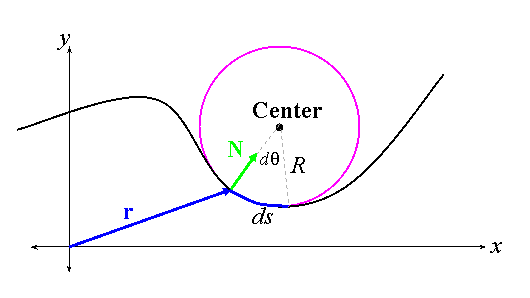

Mölder has pointed to four types of conically symmetric flow that border on uniform and parallel flow and that have potential application for constructing intake surfaces.
Osculator plane series#
Note that, the series of two-dimensional osculating planes can be scaled and obtained from the parent flowfield (curved-slope axisymmetric converging flow or other types of axisymmetric converging flow). These two-dimensional osculating planes are then superimposed along the circumference. Thus, this concept enables IWI to transform a three-dimensional, section-controllable (morphed) wavecatcher intake design into a series of two-dimensional osculating plane designs, only if the shocks (no matter straight or curved) have same strength in different osculating planes. Sobieczhy showed that a general, three-dimensional supersonic flow equation can be represented with second order accuracy by an axisymmetric flow equation in osculating cone theory, in which the axis is located in its osculating plane. In 2005, a concept and design method for the Internal Wavecatcher Intake (IWI) has been advanced by NUAA, which utilized cross section-controllable transition morphing based on the osculating axisymmetric theory. At Mach 3.85, the intake captured about 83% of available mass flow with a pressure ratio π e = 11.92, and a back-pressure ratio tolerance of up to 34.3 relative to tunnel static pressure. Based on the experimental results, at Mach 5.3, the intake captured nearly total mass air flow, with pressure ratio π e = 29.9, and a back-pressure ratio tolerance of 89 relative to tunnel static pressure. The experiments were conducted at NUAA in Mach 3.85/5.3 blow-down facility. The experimental model and schlieren image (flowfield at M3.85) of rectangular stream-tube stream-traced and truncated Busemann intake. If this osculating plane is transformed to the absolute origin, the contour will be on the real y ^ z ^ plane.įig. It should be clear by now that the foundation model for this equation is the use of Fourier series.įirst, note that a contour is located in a plane in R 3, thus a correspondence between the complex plane (Fourier series are defined in the complex plane) and a 3D plane is defined as follows: the first column vector of B i s (i.e., t i s) defines the normal vector to the contour plane this plane has a 2D orthogonal system defined by the second and third column vectors of B s. Until this point, the contour part c i( s, ω) of this formula has been missing. Regardless of the complexity of this expression (i.e., imagine it written explicitly with equations for B i s and h i s), we can see that the contour part ( c i s, ω) should describe a closed contour in the y ^ z ^ plane, since the plane tangent is perpendicular to the tangent vector t i s, related to the canonical vector x ^. (6.21) rgc i s, ω = B i s c i s, ω + h i s The radius of curvature of the sphere equals the radius r of the sphere for all normal sections. Therefore, the curvature of the great circle is the normal curvature of the sphere. The plane defined by T and M is normal to the sphere. All planes that contain the centre of the sphere cut the surface along circles with radius r that are called great circles. The vectors T and M define a plane that passes through the centre of the sphere. The radius of curvature of C is r cos θ. The vectors T and N define a plane that cuts the sphere along the curve C. The normal to the parallel is N, the normal to the sphere is M, and the angle between these vectors is θ. As curve C we have chosen the parallel at latitude θ. For simplicity we'll ignore the minus sign before e, f, g as this does not influence the explanations that will follow in this chapter.įor a geometrical interpretation of the role of the angle θ we refer to the meridian section of a sphere shown in Fig. As we used two of these letters to note normal vectors, we adopt the notation of Struik. A frequent alternative to the notation e, f, g is L, M, N. The proof given above follows some Italian lecture notes and is close to that given in Struik (1961). Various textbooks contain slightly different derivations of the second fundamental form and different notations for its terms.


 0 kommentar(er)
0 kommentar(er)
